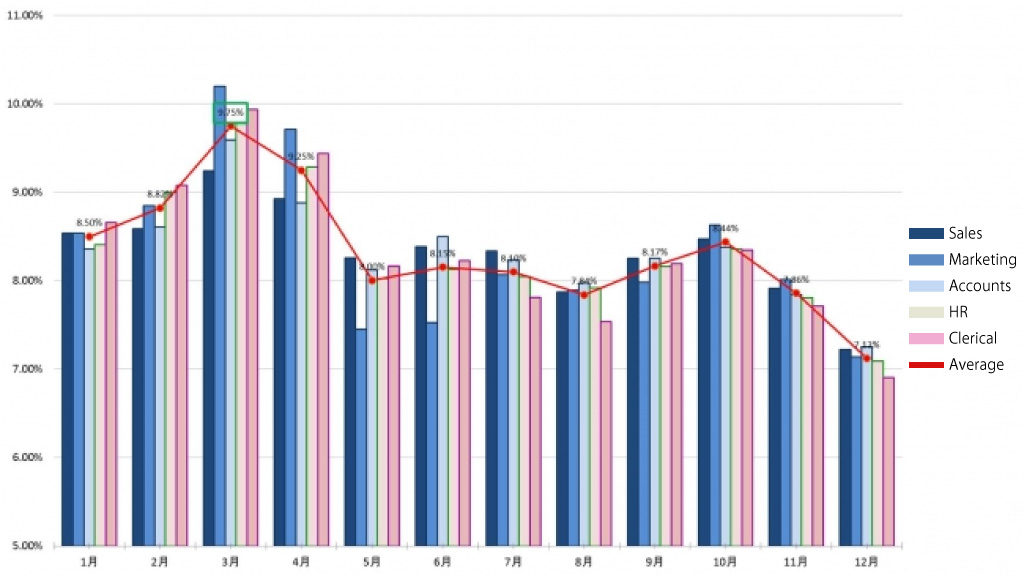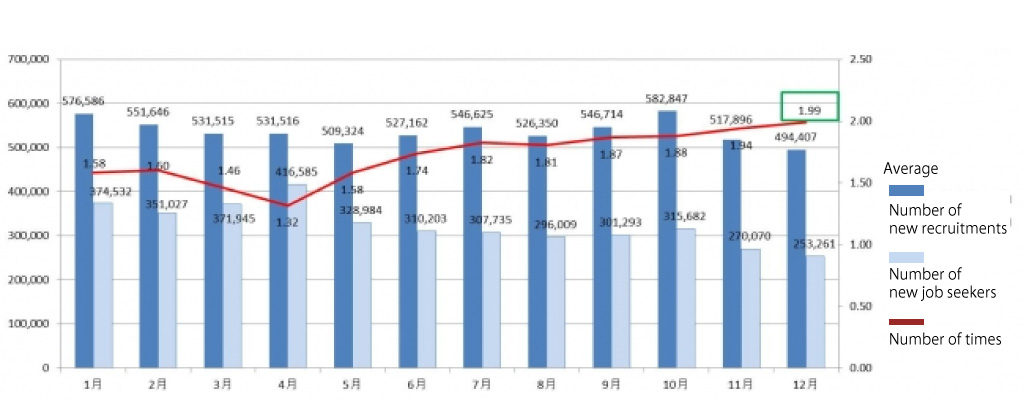December is the “target” month when looking for a job

This post is also available in 日本語
With the decrease in the working population in Japan, due to low-birth rate/ageing society, companies are facing hiring problems, and there are many opportunities for jobseekers to change employers. This is also affected by the diversification of value assigned by jobseekers to work and increase skills in job searching, which means that the number of employees changing careers has been on an upward trend* in the last several years. Companies are hiring experienced workers throughout the year, and this has increased the fluidity of the career-change market.
*1 From the MIAC Statistics Bureau Labor Force Survey long-term time-series data
Contents
So, what is the optimal period for those looking to change career to look for work?
Indeed (world No. 1 recruitment search engine used by more jobseekers than any other around the world) analyzed the trends in the period cycle for jobseekers looking to change careers throughout the year and second graduates(currently employed recent graduates) and job types, based on data in the six years from 2013, when the Japanese entity of Indeed was founded, until 2019. Additionally, this was compared with six years of statistical data from “Status of general job placements” by the Ministry of Health, Labour, and Welfare, to survey the optimal period to go job hunting for people looking to change careers. As a result, the following information was clarified.
- The highest number of jobseekers carrying out recruitment searches (sales, marketing, accounts, HR, clerical) is in March
- The most searches including the keywords “Second graduates”, “Already graduated” is during April
- The “target period” for people looking for work is December

Figure 1: Search share by job type in Indeed for each month (average over 6 years)
Note) The above graph shows the share of the number of searches for five representative fields (sales, marketing, accounts, HR, clerical) for each month with 12 months as 100%. (The share for each month was calculated from January 2013 to April 2019)
The highest number of jobseekers (sales, marketing, accounts, HR, clerical) performing job searches is in March
We can see that the five representative fields (sales, marketing, accounts, HR, clerical) were most searched in March, followed by April (Figure 1). This trend was the same for all five professions, but the search share in March and April was significantly high for marketing in particular. It can be surmised that, as the fiscal year for most companies ends in March, people considering their allocation and role for the new year are searching for work during this time. However, the lowest ratio of searches for all five of these fields is in December.
The highest number of searches including the keywords of “Second graduates” and “Existing graduates” is in April
We can see that the highest ratio of searches including the keywords of “Second graduates” and “Existing graduates” is in April (Figure 2). It is suggested that this is because the majority of people desiring hiring under the framework of second graduates or existing graduates would be doing so in April. It is thought that, due to mismatches with the companies they entered after graduating in April, people are already considering career change at this early stage.

Figure 2: ”Second graduate/existing graduate” search ratio in Indeed for each month (average over 6 years)
“Target” month for job searches when trying to change career is December
From Figure 1, we can see that the ratio of recruitment searches in Indeed is lowest during December. In other words, of the people performing recruitment searches throughout the year, relatively few of these are in December, so it can be said to be the period when “there are fewer jobseeker rivals”.
Next, let us look at the trends of recruitment and demands for job seekers throughout the year in Japan, based on statistical data from the Ministry of Health, Labour, and Welfare. Figure 3 shows the average of “Number of new recruitments”, “Number of new job seekers” and “the ratio of ‘New recruitments’ in relation to ‘New job seekers’” for each month in the six years from 2013 to 2018 in “Status of general job placements” by the Ministry of Health, Labour, and Welfare. The “Number of new recruitments” is the total number of hires for which recruitment newly started, and the “Total number of new job seekers” represents the number of people newly looking for a job. From this data, we can see that the ratio of “New recruitments” in relation to “New job seekers” is highest during December.
In December, there is a high supply of recruitments for jobseekers, and based on the fact that even in Indeed the search ratio by job seekers is low (fewer people looking for recruitment), it can be said that December is a “target” month for those looking for work.

Figure 3: Ministry of Health, Labour, and Welfare “Status of general job placements”[actual number] (excluding part-time jobs)(average between 2013 and 2018)
■Survey overview
Period to survey: January 2013 to April 2019
Survey method: We calculated the average number of searches for each month in Indeed for various key words during the target period.
(With the search ratio for each month in terms of the ratio of number of searches over 12 months)
Surveyed keywords: 1.Sales, Marketing, Accounts, HR, Clerical 2. Second graduates/existing graduates
Reference: https://prtimes.jp/main/html/rd/p/000000016.000028842.html
- How Many Can You Answer? [Résumé Quiz] – Pictures, Information, and More (Part 1)
- [Explained by a Legal Professional] Points to consider when you wish to work in Japan
- How to Write/ “Taishokunegai (Resignation Requests)” and “Taishokutodoke (Resignation Notices)”
- [For Foreign Nationals] Examples of Questions Frequently Asked at Interviews
- [Explained by a Legal Professional] Different Types of Status of Residence and its Rules









